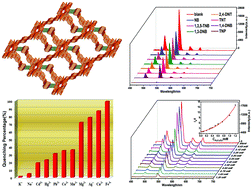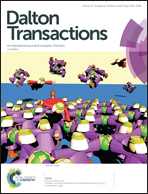Lanthanide-MOFs constructed from mixed dicarboxylate ligands as selective multi-responsive luminescent sensors†
Abstract
Five novel Ln-MOFs associated with the mixed ligands of 4-(pyridin-3-yloxy)-phthalic acid (H2ppda) and terephthalic acid (H2bdc), namely, [Ln(ppda)(bdc)0.5(C2H5OH)(H2O)]n (Ln = Sm (1), Eu (2), Gd (3), Tb (4), and Dy (5)) were synthesized under the solvothermal conditions. Compounds 1–5 exhibit the isostructural 2D layered structures. The solid-state luminescence properties of compounds 1, 2, 4 and 5 were investigated in detail. It was found that compound 4 not only detected nitrobenzene derivatives-based explosives with high selectivity, sensitivity, and recyclability, but also served as an excellent selective sensing material for Fe3+ ion and Cr2O72− ion. In particular, it is worth noting that the detection limit of TNP can reach 3.0 × 10−8 M. It was found that the free oxygen atoms of the ether bond, which function as the Lewis basic sites in Ln-MOFs, might interact with metal ions. In addition, the sensing mechanisms of 4 for different analytes were explored further.



 Please wait while we load your content...
Please wait while we load your content...